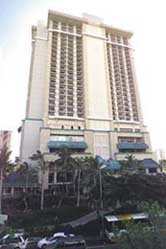
Hilton Hawaiian Village’s Kalia Tower (Hawaii’s newest hotel, which cost $95 million and opened in May 2001) was shut down completely after investigations turned up more mold as each guestroom was inspected.
Among the guests who had to be accommodated in other hotels were the annual convention of the National Medical Association and the Sheet Metal Workers’ International Association (SMWIA). The American Society of Heating, Refrigerating, and Air-Conditioning Engineers’ (ASHRAE’s) Annual Meeting was held in other sections of the Hawaiian Village in late June, before the news was reported locally.
‘THE MOLD CAME BACK’
Peter Schall, senior vice president and managing director of the hotel, told theHonolulu Star-Bulletinthat the mold in the Kalia Tower was first discovered on furniture by a housekeeper in early June.However, it was reported that several union housekeepers working in the Kalia Tower told Local 5 that they came across mold as long ago as March. After telling their managers about the mold, the workers said they were told to clean it up using regular housekeeping techniques. This information was later confirmed by Schall, although he was nonspecific as to the dates.
After the cleaning, “The mold came back,” said Adoracion Francisco, a union organizer and 20-year housekeeper.
The molds have been identified as Cladosporium and Eurotium; the Eurotium is said to be a possible forerunner to Aspergillus, which is potentially dangerous. The scanning electron micrograph (SEM), pictured above, far right, shows both Aspergillus (big cluster at left) and Eurotium (disk-shaped spores in smaller clumps and individuals), according to Jeffrey C. May, author of My House is Killing Me! The Home Guide for Families with Allergies and Asthma.
According to the Environmental Protection Agency (EPA), molds such as varieties of Aspergillus and Stachybotrys (the latter is not implicated at the Kalia Tower) “can produce toxic substances called mycotoxins.” Inhalation exposure to mycotoxins can produce symptoms including “mucous membrane irritation, skin rash, nausea, immune system suppression, acute or chronic liver damage, acute or chronic central nervous system damage, endocrine effects, and cancer,” states the EPA website (www.epa.gov).
According to recent reports, 14 workers at the Kalia Tower reported health symptoms caused by exposure to mold in the tower. Ten said they had irritation of the eye, nose, and throat; two said they had skin rashes; and two reported their asthma had worsened.
Schall said that since the hotel was reported to be closed, management also has been contacted by a few guests who said they had symptoms.
Dr. Joseph Jarvis, associate professor of the University of Nevada School of Medicine, said he questioned workers in the Kalia and Lagoon towers. (Mold was found in a corridor of the recently renovated Lagoon Tower.) Workers from the Tapa Tower were also questioned. No evidence of allergic respiratory illness was reported.
The Tapa, where most ASHRAE sessions were held, was said to have mold levels “more typical of any building,” according to the Star-Bulletin. The Lagoon had mold that was “confined to ceilings in a third-floor corridor.” Only workers from the Kalia Tower reported symptoms.

POOR BUILDING DESIGN?
An early investigation by Air Quality Services Inc., Atlanta, GA, showed that humidity in the guest-rooms was higher than normal. The cause of the high indoor humidity has not yet been determined, although it seems likely to have been caused by a combination of conditions.Designing for acceptable indoor relative humidity is tricky in the tropics, according to Fred Kohloss, a prominent Honolulu consulting engineer. Kohloss took part in a 2002 ASHRAE session, “Moisture Management in Hawaii and Other Tropical Climates.”
He offered The News his own speculation: “In most hotels in Hawaii, there are no primary outdoor air preconditioners — just infiltration.” In general, there is no pressurization to keep humid outdoor air out. A strong, constant wind effect aids infiltration of moist, untreated outdoor air, he said.

Factors other than air conditioning can create conditions suitable for mold growth in hotels, he stated. “Water infiltration can come from such sources as roof leaks and inadequate sealing of wall joints and flashings.” In addition, moisture can be trapped by vinyl-type wallpaper used in many hotels here.
“Mold grows readily at around 65% RH,” Kohloss said. “It’s relatively inexpensive to design for 50% RH in the temperate zone. However, it’s more expensive to keep the indoor humidity much below 60% under all conditions of load in Hawaii.
“Our practice is to precool and prehumidify,” he said.
Since the Hilton’s mold problems were reported, mold has also been cited in The University of Hawaii, the Prince Kuhio Federal Building, the U.S. District Courthouse in downtown Honolulu, and in several homes. Previous instances included a two-story Maui building last year, and the Maile Tower of the Hale Koa Hotel in Honolulu in 1995.
Publication date: 09/02/2002

Report Abusive Comment